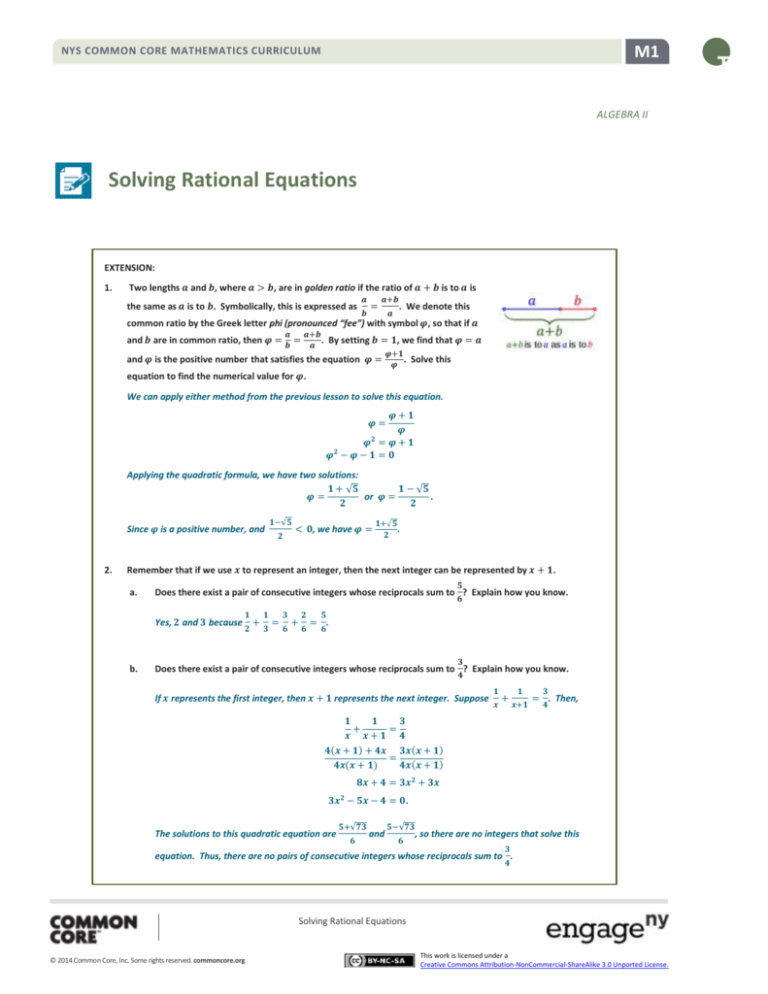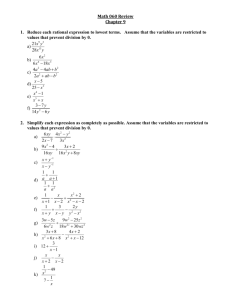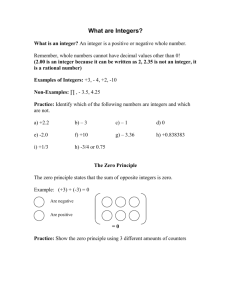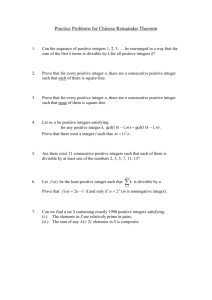
M1
NYS COMMON CORE MATHEMATICS CURRICULUM
ALGEBRA II
Solving Rational Equations
EXTENSION:
1.
Two lengths 𝒂 and 𝒃, where 𝒂 > 𝒃, are in golden ratio if the ratio of 𝒂 + 𝒃 is to 𝒂 is
the same as 𝒂 is to 𝒃. Symbolically, this is expressed as
𝒂
𝒃
=
𝒂+𝒃
𝒂
. We denote this
common ratio by the Greek letter phi (pronounced “fee”) with symbol 𝝋, so that if 𝒂
𝒂 𝒂+𝒃
=
. By setting 𝒃 = 𝟏, we find that 𝝋 = 𝒂
𝒃
𝒂
𝝋+𝟏
and 𝝋 is the positive number that satisfies the equation 𝝋 =
. Solve this
𝝋
and 𝒃 are in common ratio, then 𝝋 =
equation to find the numerical value for 𝝋.
We can apply either method from the previous lesson to solve this equation.
𝝋+𝟏
𝝋
𝝋𝟐 = 𝝋 + 𝟏
𝝋𝟐 − 𝝋 − 𝟏 = 𝟎
𝝋=
Applying the quadratic formula, we have two solutions:
𝟏 + √𝟓
𝟏 − √𝟓
𝝋=
or 𝝋 =
.
𝟐
𝟐
Since 𝝋 is a positive number, and
2.
𝟏−√𝟓
𝟐
< 𝟎, we have 𝝋 =
𝟏+√𝟓
.
𝟐
Remember that if we use 𝒙 to represent an integer, then the next integer can be represented by 𝒙 + 𝟏.
a.
𝟓
Does there exist a pair of consecutive integers whose reciprocals sum to ? Explain how you know.
𝟔
Yes, 𝟐 and 𝟑 because
b.
𝟏
𝟐
+
𝟏
𝟑
=
𝟑
𝟔
+
𝟐
𝟔
𝟓
= .
𝟔
𝟑
Does there exist a pair of consecutive integers whose reciprocals sum to ? Explain how you know.
𝟒
If 𝒙 represents the first integer, then 𝒙 + 𝟏 represents the next integer. Suppose
𝟏
𝒙
+
𝟏
𝒙+𝟏
𝟑
= . Then,
𝟒
𝟏
𝟏
𝟑
+
=
𝒙 𝒙+𝟏 𝟒
𝟒(𝒙 + 𝟏) + 𝟒𝒙 𝟑𝒙(𝒙 + 𝟏)
=
𝟒𝒙(𝒙 + 𝟏)
𝟒𝒙(𝒙 + 𝟏)
𝟖𝒙 + 𝟒 = 𝟑𝒙𝟐 + 𝟑𝒙
𝟑𝒙𝟐 − 𝟓𝒙 − 𝟒 = 𝟎.
The solutions to this quadratic equation are
𝟓+√𝟕𝟑
𝟔
and
𝟓−√𝟕𝟑
𝟔
, so there are no integers that solve this
𝟑
equation. Thus, there are no pairs of consecutive integers whose reciprocals sum to .
𝟒
Solving Rational Equations
© 2014 Common Core, Inc. Some rights reserved. commoncore.org
This work is licensed under a
Creative Commons Attribution-NonCommercial-ShareAlike 3.0 Unported License.
T
M1
NYS COMMON CORE MATHEMATICS CURRICULUM
ALGEBRA II
c.
𝟑
Does there exist a pair of consecutive even integers whose reciprocals sum to ? Explain how you know.
𝟒
If 𝒙 represents the first integer, then 𝒙 + 𝟐 represents the next even integer. Suppose
𝟏
𝒙
+
𝟏
𝒙+𝟐
𝟑
= . Then,
𝟒
𝟏
𝟏
𝟑
+
=
𝒙 𝒙+𝟐 𝟒
𝟒(𝒙 + 𝟐) + 𝟒𝒙 𝟑𝒙(𝒙 + 𝟐)
=
𝟒𝒙(𝒙 + 𝟐)
𝟒𝒙(𝒙 + 𝟐)
𝟖𝒙 + 𝟖 = 𝟑𝒙𝟐 + 𝟔𝒙
𝟐
𝟑𝒙 − 𝟐𝒙 − 𝟖 = 𝟎.
𝟒
𝟑
The solutions to this quadratic equation are − and 𝟐; therefore, the only even integer 𝒙 that solves the
𝟑
equation is 𝟐. Then, 𝟐 and 𝟒 are consecutive even integers whose reciprocals sum to .
𝟒
d.
𝟓
Does there exist a pair of consecutive even integers whose reciprocals sum to ? Explain how you know.
𝟔
If 𝒙 represents the first integer, then 𝒙 + 𝟐 represents the next even integer. Suppose
𝟏
𝒙
+
𝟏
𝒙+𝟐
𝟓
= . Then,
𝟔
𝟏
𝟏
𝟓
+
=
𝒙 𝒙+𝟐 𝟔
𝟔(𝒙 + 𝟐) + 𝟔𝒙 𝟓𝒙(𝒙 + 𝟐)
=
𝟔𝒙(𝒙 + 𝟐)
𝟔𝒙(𝒙 + 𝟐)
𝟏𝟐𝒙 + 𝟏𝟐 = 𝟓𝒙𝟐 + 𝟏𝟎𝒙
𝟓𝒙𝟐 − 𝟐𝒙 − 𝟏𝟐 = 𝟎.
The solutions to this quadratic equation are
𝟏+√𝟔𝟏
𝟓
and
𝟏−√𝟔𝟏
𝟓
, so there are no integers that solve this
𝟓
equation. Thus, there are no pairs of consecutive even integers whose reciprocals sum to .
𝟔
Solving Rational Equations
© 2014 Common Core, Inc. Some rights reserved. commoncore.org
This work is licensed under a
Creative Commons Attribution-NonCommercial-ShareAlike 3.0 Unported License.
T










